2011 NISSAN 370Z COUPE engine overheat
[x] Cancel search: engine overheatPage 330 of 419

Black plate (328,1)
Model "Z34-D" EDITED: 2010/ 7/ 27
temperature control to maximum hot and fan
control to high speed.
3. If engine overheating is caused by climbing a long hill on a hot day, run the engine at a
fast idle (approximately 1,500 rpm) until the
temperature gauge indication returns to
normal.
4. Get out of the vehicle. Look and listen for steam or coolant escaping from the radiator
before opening the hood. (If steam or
coolant is escaping, turn off the engine.)
Do not open the hood further until no steam
or coolant can be seen.
5. Open the engine hood.
WARNING
If steam or water is coming from the
engine, stand clear to prevent getting
burned.
6. Visually check if the cooling fan is running. The radiator hoses and radiator should not
leak water. If coolant is leaking or the cooling
fan does not run, stop the engine.
WARNING
Be careful not to allow your hands, hair,
jewelry or clothing to come into contact with, or get caught in, engine belts or
the engine cooling fan. The engine
cooling fan can start at any time.
7. After the engine cools down, check the coolant level in the reservoir with the engine
running. Add coolant to the reservoir if
necessary. Have your vehicle repaired at
the nearest NISSAN dealer. When towing your vehicle, all State (Provincial in
Canada) and local regulations for towing must
be followed. Incorrect towing equipment could
damage your vehicle. Towing instructions are
available from a NISSAN dealer. Local service
operators are familiar with the applicable laws
and procedures for towing. To assure proper
towing and to prevent accidental damage to
your vehicle, NISSAN recommends that you
have a service operator tow your vehicle. It is
advisable to have the service operator carefully
read the following precautions.
WARNING
.
Never ride in a vehicle that is being
towed.
. Never get under your vehicle after it
has been lifted by a tow truck.
CAUTION
.When towing, make sure that the
transmission, axles, steering system
and drivetrain are in working condi-
tion. If any unit is damaged, dollies
must be used.
. Always attach safety chains before
towing.TOWING YOUR VEHICLE
6-16
In case of emergency
Page 352 of 419
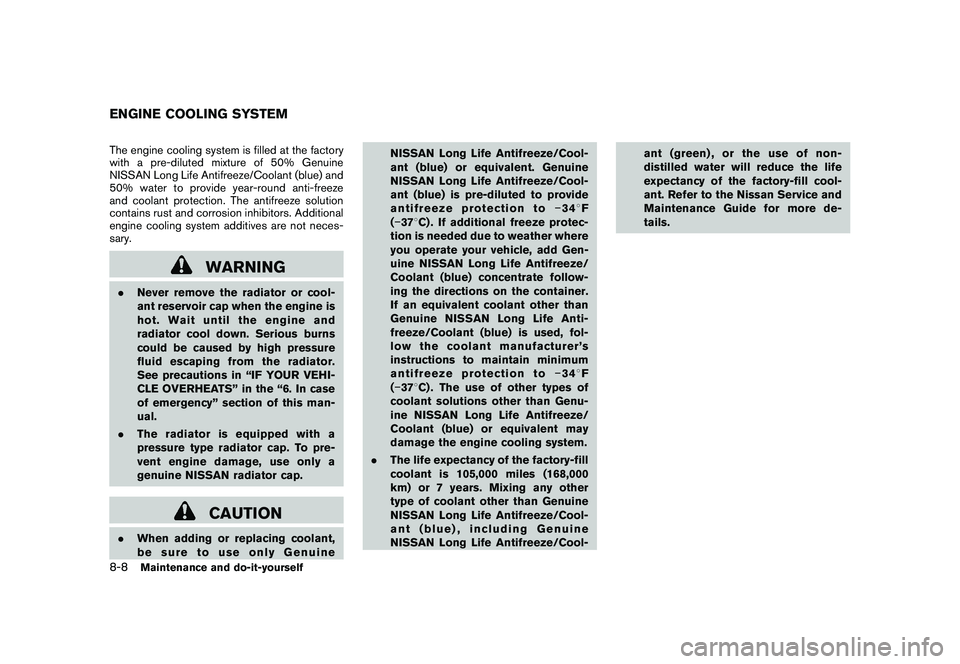
Black plate (352,1)
Model "Z34-D" EDITED: 2010/ 7/ 27
The engine cooling system is filled at the factory
with a pre-diluted mixture of 50% Genuine
NISSAN Long Life Antifreeze/Coolant (blue) and
50% water to provide year-round anti-freeze
and coolant protection. The antifreeze solution
contains rust and corrosion inhibitors. Additional
engine cooling system additives are not neces-
sary.
WARNING
.Never remove the radiator or cool-
ant reservoir cap when the engine is
hot. Wait until the engine and
radiator cool down. Serious burns
could be caused by high pressure
fluid escaping from the radiator.
See precautions in “IF YOUR VEHI-
CLE OVERHEATS” in the “6. In case
of emergency” section of this man-
ual.
. The radiator is equipped with a
pressure type radiator cap. To pre-
vent engine damage, use only a
genuine NISSAN radiator cap.
CAUTION
.When adding or replacing coolant,
be sure to use only Genuine NISSAN Long Life Antifreeze/Cool-
ant (blue) or equivalent. Genuine
NISSAN Long Life Antifreeze/Cool-
ant (blue) is pre-diluted to provide
antifreeze protection to
�34 8F
( � 37 8C) . If additional freeze protec-
tion is needed due to weather where
you operate your vehicle, add Gen-
uine NISSAN Long Life Antifreeze/
Coolant (blue) concentrate follow-
ing the directions on the container.
If an equivalent coolant other than
Genuine NISSAN Long Life Anti-
freeze/Coolant (blue) is used, fol-
low the coolant manufacturer’s
instructions to maintain minimum
antifreeze protection to �34 8F
( � 37 8C) . The use of other types of
coolant solutions other than Genu-
ine NISSAN Long Life Antifreeze/
Coolant (blue) or equivalent may
damage the engine cooling system.
. The life expectancy of the factory-fill
coolant is 105,000 miles (168,000
km) or 7 years. Mixing any other
type of coolant other than Genuine
NISSAN Long Life Antifreeze/Cool-
ant (blue) , including Genuine
NISSAN Long Life Antifreeze/Cool- ant (green) , or the use of non-
distilled water will reduce the life
expectancy of the factory-fill cool-
ant. Refer to the Nissan Service and
Maintenance Guide for more de-
tails.ENGINE COOLING SYSTEM8-8
Maintenance and do-it-yourself
Page 353 of 419
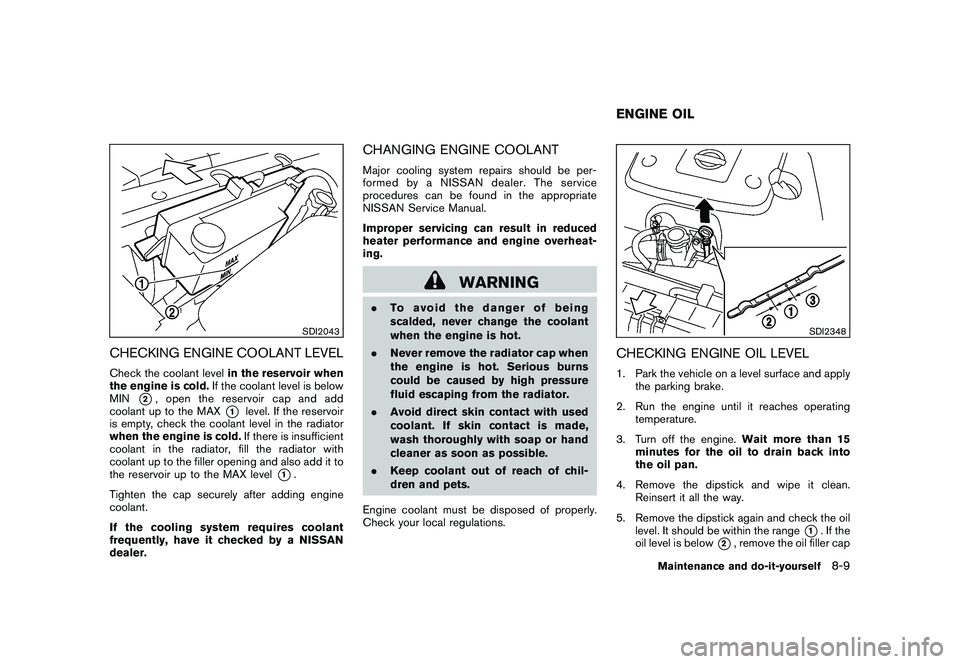
Black plate (353,1)
Model "Z34-D" EDITED: 2010/ 7/ 27
SDI2043
CHECKING ENGINE COOLANT LEVELCheck the coolant levelin the reservoir when
the engine is cold. If the coolant level is below
MIN
*2, open the reservoir cap and add
coolant up to the MAX
*1
level. If the reservoir
is empty, check the coolant level in the radiator
when the engine is cold. If there is insufficient
coolant in the radiator, fill the radiator with
coolant up to the filler opening and also add it to
the reservoir up to the MAX level
*1.
Tighten the cap securely after adding engine
coolant.
If the cooling system requires coolant
frequently, have it checked by a NISSAN
dealer.
CHANGING ENGINE COOLANTMajor cooling system repairs should be per-
formed by a NISSAN dealer. The service
procedures can be found in the appropriate
NISSAN Service Manual.
Improper servicing can result in reduced
heater performance and engine overheat-
ing.
WARNING
. To avoid the danger of being
scalded, never change the coolant
when the engine is hot.
. Never remove the radiator cap when
the engine is hot. Serious burns
could be caused by high pressure
fluid escaping from the radiator.
. Avoid direct skin contact with used
coolant. If skin contact is made,
wash thoroughly with soap or hand
cleaner as soon as possible.
. Keep coolant out of reach of chil-
dren and pets.
Engine coolant must be disposed of properly.
Check your local regulations.
SDI2348
CHECKING ENGINE OIL LEVEL1. Park the vehicle on a level surface and apply the parking brake.
2. Run the engine until it reaches operating temperature.
3. Turn off the engine. Wait more than 15
minutes for the oil to drain back into
the oil pan.
4. Remove the dipstick and wipe it clean. Reinsert it all the way.
5. Remove the dipstick again and check the oil level. It should be within the range
*1. If the
oil level is below
*2, remove the oil filler cap
ENGINE OIL
Maintenance and do-it-yourself
8-9
Page 389 of 419
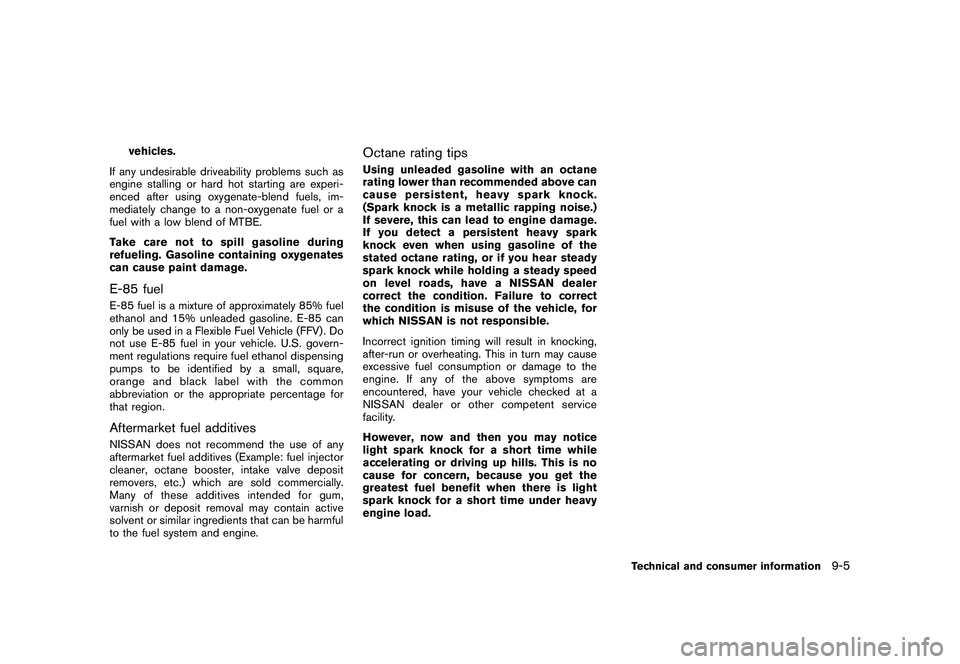
Black plate (389,1)
Model "Z34-D" EDITED: 2010/ 7/ 27
vehicles.
If any undesirable driveability problems such as
engine stalling or hard hot starting are experi-
enced after using oxygenate-blend fuels, im-
mediately change to a non-oxygenate fuel or a
fuel with a low blend of MTBE.
Take care not to spill gasoline during
refueling. Gasoline containing oxygenates
can cause paint damage.
E-85 fuelE-85 fuel is a mixture of approximately 85% fuel
ethanol and 15% unleaded gasoline. E-85 can
only be used in a Flexible Fuel Vehicle (FFV) . Do
not use E-85 fuel in your vehicle. U.S. govern-
ment regulations require fuel ethanol dispensing
pumps to be identified by a small, square,
orange and black label with the common
abbreviation or the appropriate percentage for
that region.Aftermarket fuel additivesNISSAN does not recommend the use of any
aftermarket fuel additives (Example: fuel injector
cleaner, octane booster, intake valve deposit
removers, etc.) which are sold commercially.
Many of these additives intended for gum,
varnish or deposit removal may contain active
solvent or similar ingredients that can be harmful
to the fuel system and engine.
Octane rating tipsUsing unleaded gasoline with an octane
rating lower than recommended above can
cause persistent, heavy spark knock.
(Spark knock is a metallic rapping noise.)
If severe, this can lead to engine damage.
If you detect a persistent heavy spark
knock even when using gasoline of the
stated octane rating, or if you hear steady
spark knock while holding a steady speed
on level roads, have a NISSAN dealer
correct the condition. Failure to correct
the condition is misuse of the vehicle, for
which NISSAN is not responsible.
Incorrect ignition timing will result in knocking,
after-run or overheating. This in turn may cause
excessive fuel consumption or damage to the
engine. If any of the above symptoms are
encountered, have your vehicle checked at a
NISSAN dealer or other competent service
facility.
However, now and then you may notice
light spark knock for a short time while
accelerating or driving up hills. This is no
cause for concern, because you get the
greatest fuel benefit when there is light
spark knock for a short time under heavy
engine load.
Technical and consumer information
9-5
Page 412 of 419
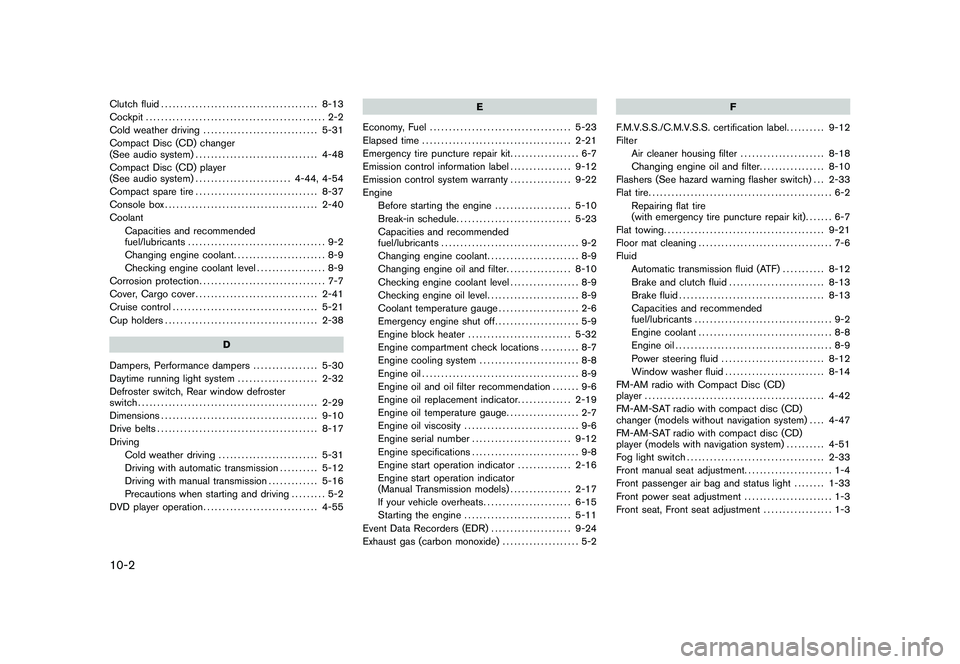
Black plate (2,1)
10-2Clutch fluid......................................... 8-13
Cockpit ............................................... 2-2
Cold weather driving .............................. 5-31
Compact Disc (CD) changer
(See audio system) ................................ 4-48
Compact Disc (CD) player
(See audio system) ......................... 4-44, 4-54
Compact spare tire ................................ 8-37
Console box ........................................ 2-40
Coolant Capacities and recommended
fuel/lubricants .................................... 9-2
Changing engine coolant ........................ 8-9
Checking engine coolant level .................. 8-9
Corrosion protection ................................. 7-7
Cover, Cargo cover ................................ 2-41
Cruise control ...................................... 5-21
Cup holders ........................................ 2-38
D
Dampers, Performance dampers ................. 5-30
Daytime running light system ..................... 2-32
Defroster switch, Rear window defroster
switch ............................................... 2-29
Dimensions ......................................... 9-10
Drive belts .......................................... 8-17
Driving Cold weather driving .......................... 5-31
Driving with automatic transmission .......... 5-12
Driving with manual transmission ............. 5-16
Precautions when starting and driving ......... 5-2
DVD player operation .............................. 4-55 E
Economy, Fuel ..................................... 5-23
Elapsed time ....................................... 2-21
Emergency tire puncture repair kit .................. 6-7
Emission control information label ................ 9-12
Emission control system warranty ................ 9-22
Engine Before starting the engine .................... 5-10
Break-in schedule .............................. 5-23
Capacities and recommended
fuel/lubricants .................................... 9-2
Changing engine coolant ........................ 8-9
Changing engine oil and filter ................. 8-10
Checking engine coolant level .................. 8-9
Checking engine oil level ........................ 8-9
Coolant temperature gauge ..................... 2-6
Emergency engine shut off ...................... 5-9
Engine block heater ........................... 5-32
Engine compartment check locations .......... 8-7
Engine cooling system .......................... 8-8
Engine oil ......................................... 8-9
Engine oil and oil filter recommendation ....... 9-6
Engine oil replacement indicator .............. 2-19
Engine oil temperature gauge ................... 2-7
Engine oil viscosity .............................. 9-6
Engine serial number .......................... 9-12
Engine specifications ............................ 9-8
Engine start operation indicator .............. 2-16
Engine start operation indicator
(Manual Transmission models) ................ 2-17
If your vehicle overheats ....................... 6-15
Starting the engine ............................ 5-11
Event Data Recorders (EDR) ..................... 9-24
Exhaust gas (carbon monoxide) .................... 5-2 F
F.M.V.S.S./C.M.V.S.S. certification label. ......... 9-12
Filter Air cleaner housing filter ...................... 8-18
Changing engine oil and filter ................. 8-10
Flashers (See hazard warning flasher switch) . . . 2-33
Flat tire ................................................ 6-2
Repairing flat tire
(with emergency tire puncture repair kit) ....... 6-7
Flat towing .......................................... 9-21
Floor mat cleaning ................................... 7-6
Fluid Automatic transmission fluid (ATF) ........... 8-12
Brake and clutch fluid ......................... 8-13
Brake fluid ...................................... 8-13
Capacities and recommended
fuel/lubricants .................................... 9-2
Engine coolant ................................... 8-8
Engine oil ......................................... 8-9
Power steering fluid ........................... 8-12
Window washer fluid .......................... 8-14
FM-AM radio with Compact Disc (CD)
player ............................................... 4-42
FM-AM-SAT radio with compact disc (CD)
changer (models without navigation system) .... 4-47
FM-AM-SAT radio with compact disc (CD)
player (models with navigation system) .......... 4-51
Fog light switch .................................... 2-33
Front manual seat adjustment. ...................... 1-4
Front passenger air bag and status light ........ 1-33
Front power seat adjustment ....................... 1-3
Front seat, Front seat adjustment .................. 1-3
Model "Z34-D" EDITED: 2010/ 7/ 28
Page 414 of 419
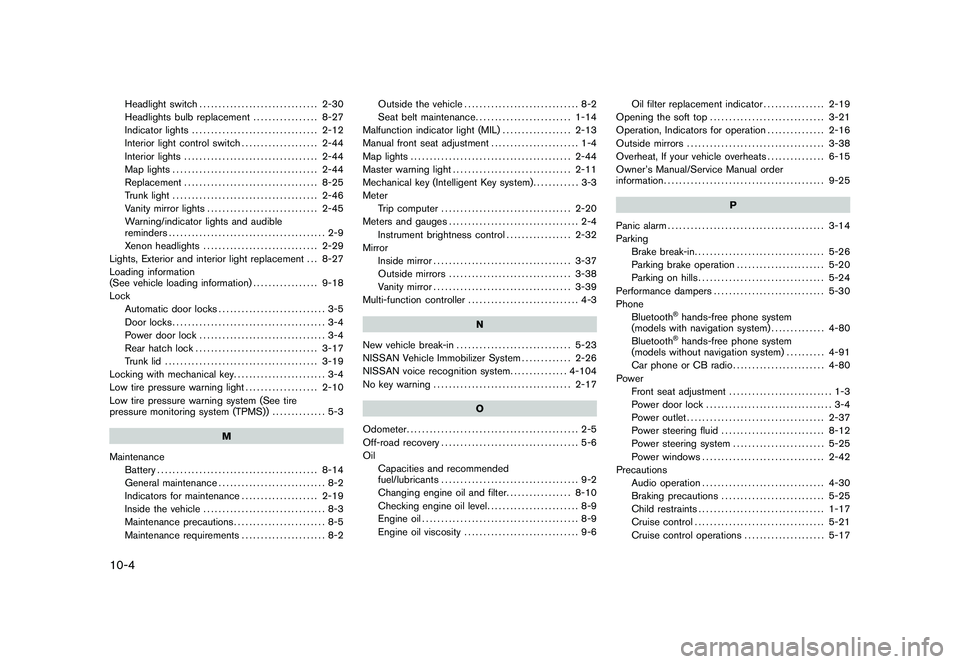
Black plate (4,1)
10-4
Headlight switch............................... 2-30
Headlights bulb replacement ................. 8-27
Indicator lights ................................. 2-12
Interior light control switch .................... 2-44
Interior lights ................................... 2-44
Map lights ...................................... 2-44
Replacement ................................... 8-25
Trunk light ...................................... 2-46
Vanity mirror lights ............................. 2-45
Warning/indicator lights and audible
reminders ......................................... 2-9
Xenon headlights .............................. 2-29
Lights, Exterior and interior light replacement . . . 8-27
Loading information
(See vehicle loading information) ................. 9-18
Lock Automatic door locks ............................ 3-5
Door locks ........................................ 3-4
Power door lock ................................. 3-4
Rear hatch lock ................................ 3-17
Trunk lid ........................................ 3-19
Locking with mechanical key ........................ 3-4
Low tire pressure warning light ................... 2-10
Low tire pressure warning system (See tire
pressure monitoring system (TPMS)) .............. 5-3
M
Maintenance Battery .......................................... 8-14
General maintenance ............................ 8-2
Indicators for maintenance .................... 2-19
Inside the vehicle ................................ 8-3
Maintenance precautions ........................ 8-5
Maintenance requirements ...................... 8-2 Outside the vehicle
.............................. 8-2
Seat belt maintenance ......................... 1-14
Malfunction indicator light (MIL) .................. 2-13
Manual front seat adjustment ....................... 1-4
Map lights .......................................... 2-44
Master warning light ............................... 2-11
Mechanical key (Intelligent Key system) ............ 3-3
Meter Trip computer .................................. 2-20
Meters and gauges .................................. 2-4
Instrument brightness control ................. 2-32
Mirror Inside mirror .................................... 3-37
Outside mirrors ................................ 3-38
Vanity mirror .................................... 3-39
Multi-function controller ............................. 4-3
N
New vehicle break-in .............................. 5-23
NISSAN Vehicle Immobilizer System ............. 2-26
NISSAN voice recognition system ............... 4-104
No key warning .................................... 2-17
O
Odometer ............................................. 2-5
Off-road recovery .................................... 5-6
Oil Capacities and recommended
fuel/lubricants .................................... 9-2
Changing engine oil and filter ................. 8-10
Checking engine oil level ........................ 8-9
Engine oil ......................................... 8-9
Engine oil viscosity .............................. 9-6 Oil filter replacement indicator
................ 2-19
Opening the soft top .............................. 3-21
Operation, Indicators for operation ............... 2-16
Outside mirrors .................................... 3-38
Overheat, If your vehicle overheats ............... 6-15
Owner’s Manual/Service Manual order
information .......................................... 9-25
P
Panic alarm ......................................... 3-14
Parking Brake break-in .................................. 5-26
Parking brake operation ....................... 5-20
Parking on hills ................................. 5-24
Performance dampers ............................. 5-30
Phone Bluetooth
®hands-free phone system
(models with navigation system) .............. 4-80
Bluetooth®hands-free phone system
(models without navigation system) .......... 4-91
Car phone or CB radio ........................ 4-80
Power Front seat adjustment ........................... 1-3
Power door lock ................................. 3-4
Power outlet .................................... 2-37
Power steering fluid ........................... 8-12
Power steering system ........................ 5-25
Power windows ................................ 2-42
Precautions Audio operation ................................ 4-30
Braking precautions ........................... 5-25
Child restraints ................................. 1-17
Cruise control .................................. 5-21
Cruise control operations ..................... 5-17
Model "Z34-D" EDITED: 2010/ 7/ 28